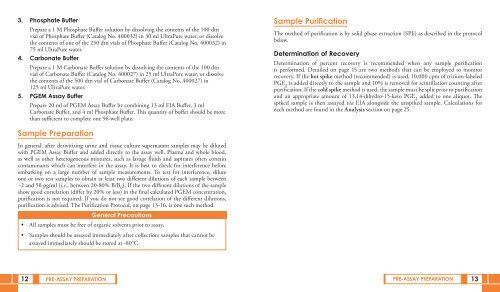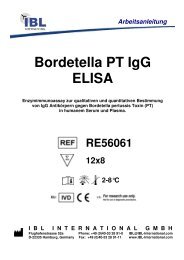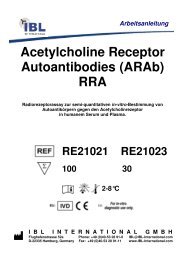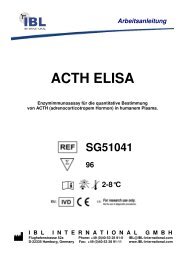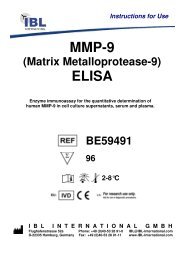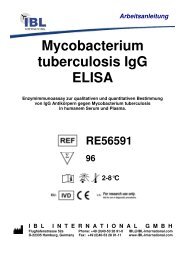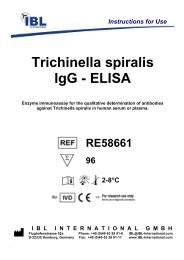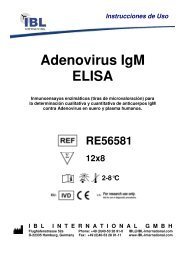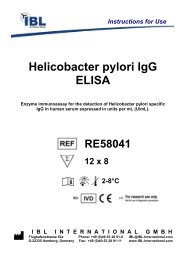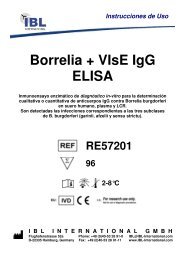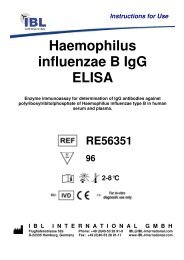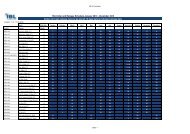Prostaglandin E2 Metabolite ELISA - IBL International
Prostaglandin E2 Metabolite ELISA - IBL International
Prostaglandin E2 Metabolite ELISA - IBL International
You also want an ePaper? Increase the reach of your titles
YUMPU automatically turns print PDFs into web optimized ePapers that Google loves.
3. Phosphate Buffer<br />
Prepare a 1 M Phosphate Buffer solution by dissolving the contents of the 100 dtn<br />
vial of Phosphate Buffer (Catalog No. 400032) in 30 ml UltraPure water, or dissolve<br />
the contents of one of the 250 dtn vials of Phosphate Buffer (Catalog No. 400032) in<br />
75 ml UltraPure water.<br />
4. Carbonate Buffer<br />
Prepare a 1 M Carbonate Buffer solution by dissolving the contents of the 100 dtn<br />
vial of Carbonate Buffer (Catalog No. 400027) in 25 ml UltraPure water, or dissolve<br />
the contents of the 500 dtn vial of Carbonate Buffer (Catalog No. 400027) in<br />
125 ml UltraPure water.<br />
5. PGEM Assay Buffer<br />
Prepare 20 ml of PGEM Assay Buffer by combining 13 ml EIA Buffer, 3 ml<br />
Carbonate Buffer, and 4 ml Phosphate Buffer. This quantity of buffer should be more<br />
than sufficient to complete one 96-well plate.<br />
Sample Preparation<br />
In general, after derivitizing urine and tissue culture supernatant samples may be diluted<br />
with PGEM Assay Buffer and added directly to the assay well. Plasma and whole blood,<br />
as well as other heterogeneous mixtures, such as lavage fluids and aspirates often contain<br />
contaminants which can interfere in the assay. It is best to check for interference before<br />
embarking on a large number of sample measurements. To test for interference, dilute<br />
one or two test samples to obtain at least two different dilutions of each sample between<br />
~2 and 50 pg/ml (i.e., between 20-80% B/B 0 ). If the two different dilutions of the sample<br />
show good correlation (differ by 20% or less) in the final calculated PGEM concentration,<br />
purification is not required. If you do not see good correlation of the different dilutions,<br />
purification is advised. The Purification Protocol, on page 13-16, is one such method.<br />
General Precautions<br />
• All samples must be free of organic solvents prior to assay.<br />
• Samples should be assayed immediately after collection; samples that cannot be<br />
assayed immediately should be stored at -80°C.<br />
Sample Purification<br />
The method of purification is by solid phase extraction (SPE) as described in the protocol<br />
below.<br />
Determination of Recovery<br />
Determination of percent recovery is recommended when any sample purification<br />
is performed. Detailed on page 15 are two methods that can be employed to monitor<br />
recovery. If the hot spike method (recommended) is used, 10,000 cpm of tritium-labeled<br />
PGE 2 is added directly to the sample and 10% is removed for scintillation counting after<br />
purification. If the cold spike method is used, the sample must be split prior to purification<br />
and an appropriate amount of 13,14-dihydro-15-keto PGE 2 added to one aliquot. The<br />
spiked sample is then assayed via EIA alongside the unspiked sample. Calculations for<br />
each method are found in the Analysis section on page 25.<br />
12 PRE-ASSAY PREPARATION PRE-ASSAY PREPARATION 13


